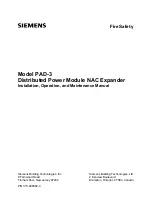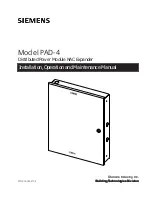
Consumer Guidelines
CONSUMER GUIDELINES
This is a CONSUMER device
BEFORE USE
, you
MUST REGISTER THIS DEVICE
with your wireless provider and have your provider’s consent. Most wireless providers consent to the use of
signal boosters. Some providers may not consent to the use of this device on their network. If you are unsure, contact your provider.
In Canada,
BEFORE USE
you must meet all requirements set out in ISED CPC-2-1-05
1
You MUST operate this device with approved antennas and cables as specified by the manufacturer. Antennas MUST be installed at least 20 cm (8 inches) from
(i.e. MUST NOT be installed within 20 cm of) any person.
You MUST cease operation of this device immediately if requested by the FCC (or ISED in Canada) or a licensed wireless service provider.
WARNING:
E911 location information may not be provided or may be inaccurate for calls served by using this device.
This device may be operated ONLY in a fixed location, for in-building use.
Register your cellular booster with your wireless carrier at the following urls:
Verizon:
verizonwireless.com/wcms/consumer/register-signal-booster.html
AT&T:
securec45.securewebsession.com/attsignalbooster.com/
T-Mobile:
support.t-mobile.com/docs/DOC-9827
Sprint:
sprint.com/legal/fcc_boosters.html
U.S. Cellular:
uscellular.com/uscellular/support/fcc-booster-registration.jsp
This device complies with Part 15 of FCC Rules. Operation is subject to the following two conditions: (1) this device may not cause harmful interference, and (2)
this device must accept any interference received, including interference that may cause undesired operation.
CAN ICES-3 (B)/NMB-3(B) (Canada) :
This Class B digital apparatus meets all requirements of the Canadian Interference Causing Equipment Regulations. Operation is subject to the following two
conditions: (1) this device may not cause harmful interference, and (2) this device must accept any interference received, including interference that may cause
undesired operation
The Manufacturer’s rated output power of this equipment is for single carrier operation. For situations when multiple carrier signals are present, the rating
would have to be reduced by 3.5 dB, especially where the output signal is re-radiated and can cause interference to adjacent band users. This power reduction
is to be by means of input power or gain reduction and not by an attenuator at the output of the device.
1 For details on the requirements specified in ISED CPC-2-1-05, visit: ic.gc.ca/eic/site/smt-gst.nsf/eng/sf08942.html
14
https://www.signalbooster.com | 855.846.2654 | [email protected]


































